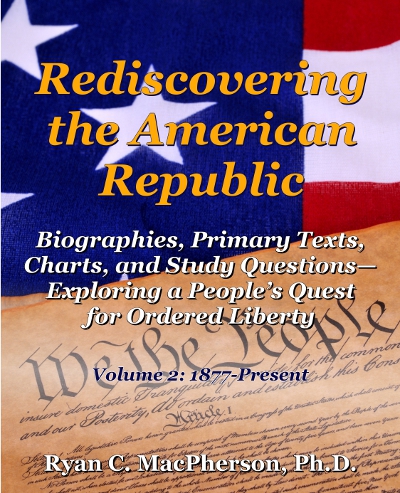Excerpted from: Rediscovering the American Republic, vol. 2: 1877–Present
Volume 1 of Rediscovering the American Republic includes classic biographies of five of the most influential people in American history through the era of the Civil War: William Penn, George Washington, Thomas Jefferson, Andrew Jackson, and Abraham Lincoln. Each of these men sought to establish both order and liberty in America, though they differed with their contemporaries as to the proper mix that would foster a lasting ordered liberty. Although none of them fully represented the era in which they lived, all of them interacted sufficiently with people of alternative persuasions to ensure that a focused study of their lives reveals a broad diversity of American experience. Primary source documents included in Volume 1 shed additional light on the challenges, triumphs, and tragedies experienced by the American people, particularly as to issues involving religious liberty, racial equality, and property rights. The proper relationship among the three branches of the federal government, and the dividing line between federal jurisdiction and states’ rights, also received significant attention.
Volume 2 continues the same tradition of historical inquiry through a combination of biographies—this time including every U.S. president from 1877 to present—and primary source documents. Once again, the analysis focuses on the proper relationship among the three branches of the federal government, and the dividing line between federal jurisdiction and states’ rights. Once again, religious liberty, racial equality, and property rights present perennial questions to which Americans give varied responses. And, once again, the overarching concern is to strike the proper balance between order and liberty—to discover that precious combination known as ordered liberty that uniquely can sustain the American Republic for generations yet to come. Through it all, a recognition of human nature, and the rights inherent in each person to life, liberty, and property, must never be forgotten.
In volume 1, primary source texts, time lines, and explanatory tables have been interspersed among the chapters of the biographies and organized into five distinct periods of American history. Similarly, in volume 2, inaugural addresses, public policy documents, and other primary source texts, plus time lines and explanatory tables, have been interspersed among the presidential biographies and organized into five distinct periods of American history. The result is full coverage of the most fundamental content essential to any advanced placement (AP) high school or introductory college survey course. Six “Deep Analysis Questions for Historians” guide the reader in probing the texts for historical significance (see p. 20). Hundreds of specific study questions bring distinct historical episodes into sharper focus. For example:
- Who won the Battle of Bunker Hill, and in what sense of “victory”? (vol. 1, p. 199)
- What were the three main policies advocated by Henry Clay, which are known collectively as the “American System”? (vol. 1, p. 472) 3. What motivated John Wilkes Booth to assassinate Abraham Lincoln? (vol. 1, p. 670)
- What was [Calvin] Coolidge’s conception of human nature, and how did this shape his political philosophy? (vol. 2, p. 337)
- What role did [Franklin D.] Roosevelt envision for the government amid the economic struggles of the Great Depression? (vol. 2, p. 383)
- What motivated the United States and the Soviet Union as each nation took part in events that resulted in the division of Germany? (vol. 2, p. 426)
- How did the political philosophies of Martin Luther King, Jr., and Malcolm X differ, and which of these two men proved more successful in accomplishing his goals? (vol. 2, p. 576)
- Define “civic virtue” and explain its role in the preservation of a republic. (vol. 2, p. 740)
Volume 1 concludes with a period known as Reconstruction (1865–1877). The Civil War (1861–1865) had ended. The republic was rebuilt—partly upon the old foundations of the Declaration of Independence and the U.S. Constitution, but also with a new twist. Three Reconstruction Amendments solved on paper problems with which Americans long had struggled: henceforth, all slaves would be free, all persons of African descent would have equal rights with whites, and all men—regardless of race—would would be permitted to vote on equal terms. In practice, however, it remained to be seen whether Americans would honor their new creed. Moreover, the old debate between federal jurisdiction and states’ rights was not resolved by the Civil War; it only was channeled away from bloody conflict back to the pens which are mightier than swords.
- To learn more, purchase:
- See also:


